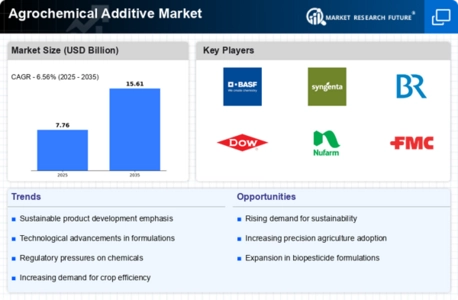Rising Demand for Crop Protection
The Agrochemical Additive Market is experiencing a notable increase in demand for crop protection solutions. This trend is driven by the need to enhance agricultural productivity and ensure food security. As the global population continues to grow, the pressure on agricultural systems intensifies, necessitating the use of effective agrochemical additives. According to recent data, the market for crop protection chemicals is projected to reach approximately USD 80 billion by 2026, indicating a robust growth trajectory. Agrochemical additives play a crucial role in improving the efficacy of these products, thereby supporting farmers in achieving higher yields and better quality crops. This rising demand for crop protection is likely to propel the Agrochemical Additive Market forward, as stakeholders seek innovative solutions to combat pests and diseases.
Growing Awareness of Sustainable Practices
The Agrochemical Additive Market is increasingly influenced by the growing awareness of sustainable agricultural practices. Farmers and consumers alike are becoming more conscious of the environmental impact of agrochemicals, leading to a demand for eco-friendly additives. This shift is prompting manufacturers to innovate and develop biodegradable and less harmful agrochemical additives. Market data indicates that the demand for sustainable agrochemicals is expected to grow at a compound annual growth rate of 7% through 2027. This trend not only reflects changing consumer preferences but also aligns with regulatory pressures aimed at reducing chemical residues in food products. As sustainability becomes a central theme in agriculture, the Agrochemical Additive Market is likely to adapt, fostering the development of products that meet these evolving standards.
Regulatory Compliance and Safety Standards
The Agrochemical Additive Market is significantly impacted by stringent regulatory compliance and safety standards. Governments and regulatory bodies are increasingly focused on ensuring the safety of agrochemical products, which necessitates the development of additives that meet these rigorous requirements. This regulatory landscape is driving innovation within the industry, as manufacturers strive to create safer and more effective agrochemical additives. Recent data suggests that the agrochemical regulatory market is projected to reach USD 5 billion by 2025, reflecting the growing importance of compliance in product development. As regulations evolve, the Agrochemical Additive Market must adapt to maintain market access and consumer trust, thereby influencing the types of additives that are developed and marketed.
Increased Adoption of Precision Agriculture
The Agrochemical Additive Market is witnessing a shift towards precision agriculture, which emphasizes the use of technology to optimize farming practices. This approach allows for the targeted application of agrochemicals, reducing waste and enhancing efficiency. The integration of data analytics, GPS technology, and remote sensing is enabling farmers to make informed decisions regarding the application of agrochemical additives. As a result, the market for precision agriculture is expected to grow significantly, with estimates suggesting a value of over USD 12 billion by 2025. This trend not only supports sustainable farming practices but also drives the demand for specialized agrochemical additives that can be tailored to specific crop needs. Consequently, the Agrochemical Additive Market is likely to benefit from this technological advancement, as it aligns with the growing emphasis on resource efficiency and environmental stewardship.
Technological Innovations in Agrochemical Formulations
The Agrochemical Additive Market is benefiting from ongoing technological innovations in agrochemical formulations. Advances in chemistry and material science are enabling the development of more effective and efficient agrochemical additives. These innovations include the creation of slow-release formulations and nanotechnology applications, which enhance the performance of agrochemicals while minimizing environmental impact. Market analysts project that the agrochemical formulation market will grow to USD 60 billion by 2026, driven by these technological advancements. As farmers seek more effective solutions to combat agricultural challenges, the demand for innovative agrochemical additives is likely to rise. This trend underscores the importance of research and development within the Agrochemical Additive Market, as companies strive to stay competitive in a rapidly evolving landscape.



.webp)
.webp)
.webp)
.webp)
.webp)
.webp)








Leave a Comment